R----stringr包介绍学习
1. stringr介绍
stringr包被定义为一致的、简单易用的字符串工具集。所有的函数和参数定义都具有一致性,比如,用相同的方法进行NA处理和0长度的向量处理。
字符串处理虽然不是R语言中最主要的功能,却也是必不可少的,数据清洗、可视化等的操作都会用到。对于R语言本身的base包提供的字符串基础函数,随着时间的积累,已经变得很多地方不一致,不规范的命名,不标准的参数定义,很难看一眼就上手使用。字符串处理在其他语言中都是非常方便的事情,R语言在这方面确实落后了。stringr包就是为了解决这个问题,让字符串处理变得简单易用,提供友好的字符串操作接口。
stringr的项目主页:https://cran.r-project.org/web/packages/stringr/index.html
2. stringr的API介绍
stringr包1.0.0版本,一共提供了30个函数,方便我们对字符串处理。常用的字符串的处理以str_开头来命名,方便更直观理解函数的定义。我们可以根据使用习惯对函数进行分类:
字符串拼接函数
- str_c: 字符串拼接。
- str_join: 字符串拼接,同str_c。
- str_trim: 去掉字符串的空格和TAB(\t)
- str_pad: 补充字符串的长度
- str_dup: 复制字符串
- str_wrap: 控制字符串输出格式
- str_sub: 截取字符串
- str_sub<- 截取字符串,并赋值,同str_sub
字符串计算函数
- str_count: 字符串计数
- str_length: 字符串长度
- str_sort: 字符串值排序
- str_order: 字符串索引排序,规则同str_sort
字符串匹配函数
- str_split: 字符串分割
- str_split_fixed: 字符串分割,同str_split
- str_subset: 返回匹配的字符串
- word: 从文本中提取单词
- str_detect: 检查匹配字符串的字符
- str_match: 从字符串中提取匹配组。
- str_match_all: 从字符串中提取匹配组,同str_match
- str_replace: 字符串替换
- str_replace_all: 字符串替换,同str_replace
- str_replace_na:把NA替换为NA字符串
- str_locate: 找到匹配的字符串的位置。
- str_locate_all: 找到匹配的字符串的位置,同str_locate
- str_extract: 从字符串中提取匹配字符
- str_extract_all: 从字符串中提取匹配字符,同str_extract
字符串变换函数
- str_conv: 字符编码转换
- str_to_upper: 字符串转成大写
- str_to_lower: 字符串转成小写,规则同str_to_upper
- str_to_title: 字符串转成首字母大写,规则同str_to_upper
参数控制函数,仅用于构造功能的参数,不能独立使用。
- boundary: 定义使用边界
- coll: 定义字符串标准排序规则。
- fixed: 定义用于匹配的字符,包括正则表达式中的转义符
- regex: 定义正则表达式
stringr包中的重要函数
| 函数 | 功能说明 | R Base中对应函数 |
|---|---|---|
| 使用正则表达式的函数 | ||
str_extract() |
提取首个匹配模式的字符 | regmatches() |
str_extract_all() |
提取所有匹配模式的字符 | regmatches() |
str_locate() |
返回首个匹配模式的字符的位置 | regexpr() |
str_locate_all() |
返回所有匹配模式的字符的位置 | gregexpr() |
str_replace() |
替换首个匹配模式 | sub() |
str_replace_all() |
替换所有匹配模式 | gsub() |
str_split() |
按照模式分割字符串 | strsplit() |
str_split_fixed() |
按照模式将字符串分割成指定个数 | - |
str_detect() |
检测字符是否存在某些指定模式 | grepl() |
str_count() |
返回指定模式出现的次数 | - |
| 其他重要函数 | ||
str_sub() |
提取指定位置的字符 | regmatches() |
str_dup() |
丢弃指定位置的字符 | - |
str_length() |
返回字符的长度 | nchar() |
str_pad() |
填补字符 | - |
str_trim() |
丢弃填充,如去掉字符前后的空格 | - |
str_c() |
连接字符 | paste(),paste0() |
3.1 字符串拼接函数
3.1.1 str_c,字符串拼接操作,与str_join完全相同,与paste()行为不完全一致。
函数定义:
str_c(..., sep = "", collapse = NULL)
str_join(..., sep = "", collapse = NULL)
参数列表:
…: 多参数的输入
sep: 把多个字符串拼接为一个大的字符串,用于字符串的分割符。
collapse: 把多个向量参数拼接为一个大的字符串,用于字符串的分割符。
str_c(c('a','a1'),c('b','b1'),sep='-')
str_c(letters[1:5], " is for", "...")
str_c('a','b',sep='-')#sep可设置连接符
str_c('a','b',collapse = "-") # collapse参数,对多个字符串无效
str_c(c('a','a1'),c('b','b1'),collapse='-')
str_c(head(letters), collapse = "") #把多个向量参数拼接为一个大的字符串
str_c(head(letters), collapse = ", ")
str_c(letters[-26], " comes before ", letters[-1])
str_c(letters)
############
#对比str_c()函数和paste()函数之间的不同点。
############
str_c('a','b') #把多个字符串拼接为一个大的字符串。
paste('a','b') # 多字符串拼接,默认的sep参数行为不一致
# 向量拼接字符串,collapse参数的行为一致
str_c(letters, collapse = "") #collapse 将一个向量的所有元素连接成一个字符串,collapse设置元素间的连接符
paste(letters, collapse = "")
#拼接有NA值的字符串向量,对NA的处理行为不一致
str_c(c("a", NA, "b"), "-d") #若为空,则无法连接
paste(c("a", NA, "b"), "-d") #即使空,也可连接
str_c(str_replace_na(c("a", NA, "b")), "-d") #即使空,也可连接
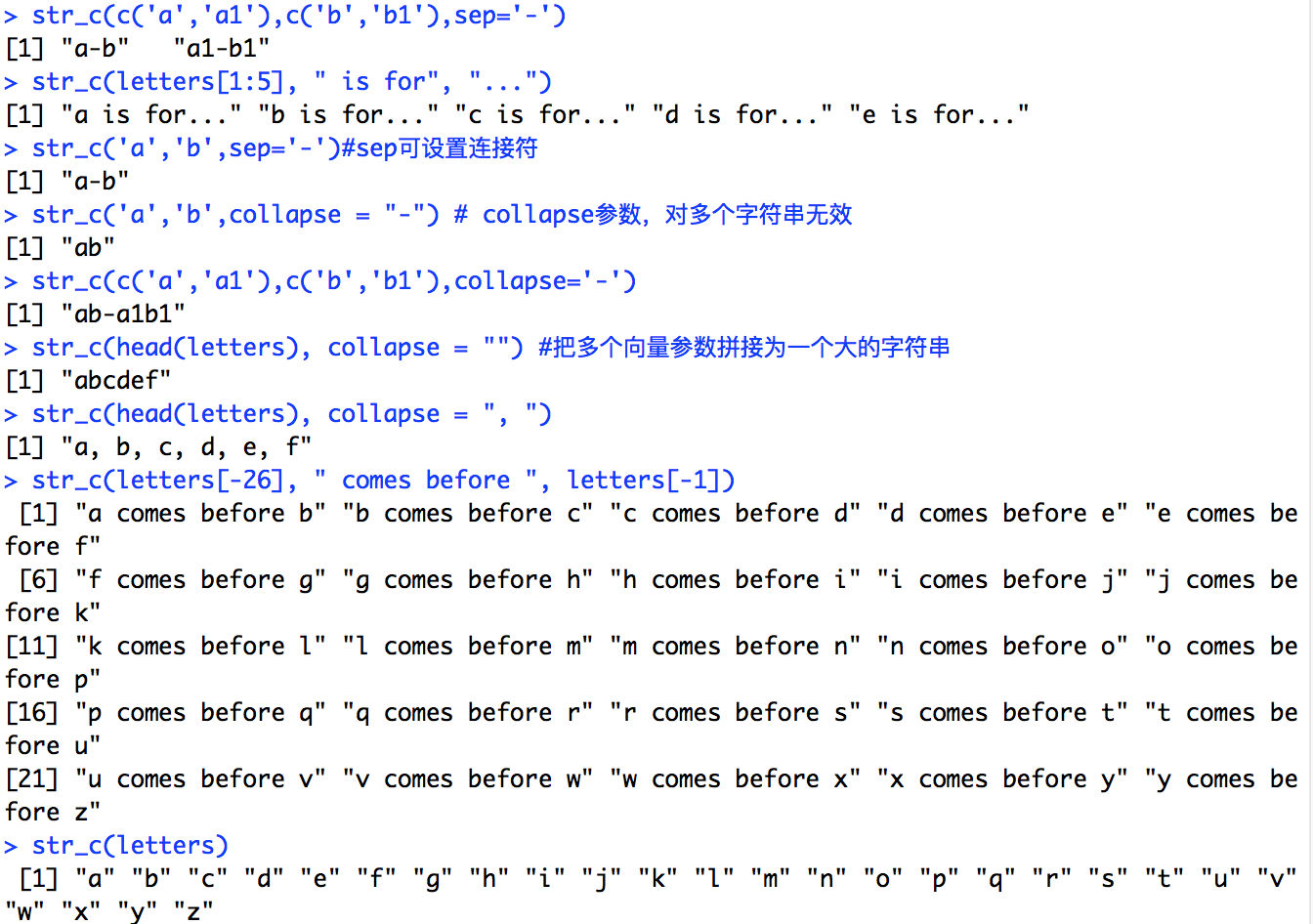

3.1.2 str_trim:去掉字符串的空格和TAB(\t)
函数定义:str_trim(string, side = c("both", "left", "right"))
参数列表:
string: 字符串,字符串向量。
side: 过滤方式,both两边都过滤,left左边过滤,right右边过滤
去掉字符串的空格和TAB(\t)
str_trim(string, side = c(“both”, “left”, “right”))
string:需要处理的字符串
side:指定剔除空格的位置,both表示剔除首尾两端空格,left表示剔除字符串首部空格,right表示剔除字符串末尾空格
string <- ‘ Why is me? I have worded hardly! ‘
str_trim(string, side = ‘left’)
str_trim(string, side = ‘right’)
str_trim(string, side = ‘both’)
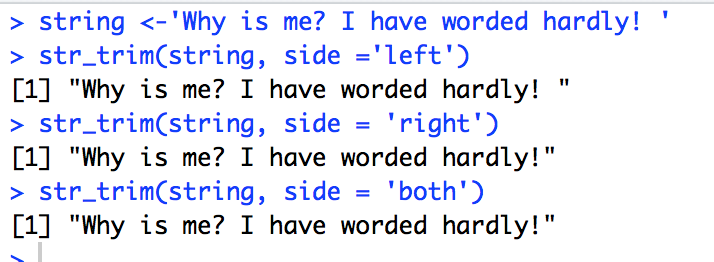
3.1.3 str_pad:补充字符串的长度
函数定义:str_pad(string, width, side = c("left", "right", "both"), pad = " ")
参数列表:
string: 字符串,字符串向量。
width: 字符串填充后的长度
side: 填充方向,both两边都填充,left左边填充,right右边填充
pad: 用于填充的字符
> string<-'ning xiao li'
> str_pad(string,10)
[1] "ning xiao li"
> str_pad(string,20)
[1] " ning xiao li"
> str_pad(string,20,side = 'both',pad = '*')
[1] "****ning xiao li****"
> string<-'ning xiao li'
> str_pad(string,10) ##注若指定的长度少于string长度时,将只返回原string
[1] "ning xiao li"
> str_pad(string,20) ## 从右边补充空格,直到字符串长度为20
[1] " ning xiao li"
> str_pad(string,20,side = 'left',pad = '*') # # 从左边补充空格,直到字符串长度为20
[1] "********ning xiao li"
> str_pad(string,20,side = 'left',pad = '*') # # 从右边补充空格,直到字符串长度为20
[1] "********ning xiao li"
> str_pad(string,20,side = 'both',pad = '*') # 从左右两边各补充x字符,直到字符串长度为20
[1] "****ning xiao li****"
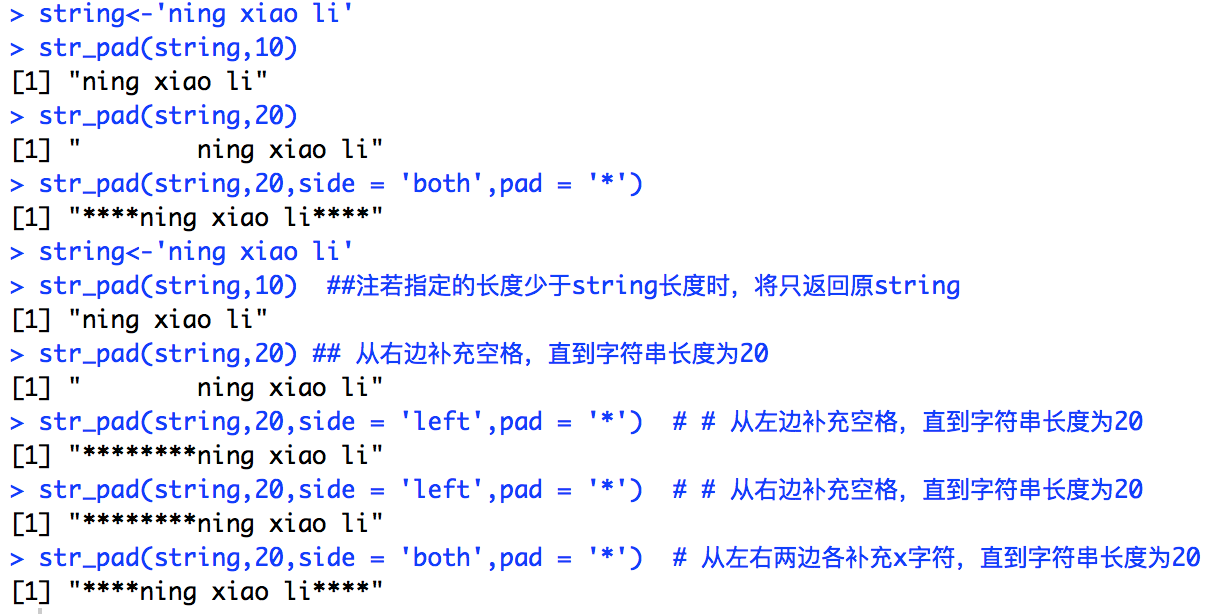
3.1.4 str_dup: 复制字符串
函数定义:str_dup(string, times)
参数列表:
string:需要重复处理的字符串
times:指定重复的次数
复制一个字符串向量。
> val <- c("abca4", 123, "cba2")
# 复制2次
> str_dup(val, 2)
# 按位置复制
> str_dup(val, 1:3)

3.1.5 str_wrap,控制字符串输出格式
函数定义:str_wrap(string, width = 80, indent = 0, exdent = 0)
参数列表:
- string: 字符串,字符串向量。
- width: 设置一行所占的宽度。
- indent: 段落首行的缩进值
- exdent: 设置第二行后每行缩进
thanks_path <- file.path(R.home("doc"), "THANKS")
thanks <- str_c(readLines(thanks_path), collapse = "\n")
thanks <- word(thanks, 1, 3, fixed("\n\n"))
cat(str_wrap(thanks), "\n")
cat(str_wrap(thanks, width = 70), "\n") # 设置宽度为70个字符
cat(str_wrap(thanks, width = 80, indent = 6, indent = 2), "\n") # 设置宽度为80字符,首行缩进2字符
cat(str_wrap(thanks, width = 80, indent = 6, exdent = 2), "\n") # 设置宽度为80字符,非首行缩进2字符
3.1.6 str_sub,截取字符串
函数定义:str_sub(string, start = 1L, end = -1L)
参数列表:
- string: 字符串,字符串向量。
- start : 开始位置
- end : 结束位置
str_sub(string, start = 1L, end = -1L) 提取子字符串
str_sub(string, start = 1L, end = -1L) <- value 替换子字符串
截取字符串。
txt <- "I am a little bird"
str_sub(txt, 1, 4) # 截取1-4的索引位置的字符串
str_sub(txt, end=6) # 截取1-6的索引位置的字符串
str_sub(txt, 6) # 截取6到结束的索引位置的字符串
str_sub(txt, c(1, 4), c(6, 8)) # 分2段截取字符串
str_sub(txt, -3) # 通过负坐标截取字符串
str_sub(txt, end = -3)
x <- "AAABBBCCC" #对截取的字符串进行赋值。
str_sub(x, 1, 1) <- 1; x ## 在字符串的1的位置赋值为1
str_sub(x, 2, -2) <- "2345"; x ## 在字符串从2到-2的位置赋值为2345

3.2 字符串计算函数
3.2.1 str_count, 字符串计数
函数定义:str_count(string, pattern = "")
参数列表:
- string: 字符串,字符串向量。
- pattern: 匹配的字符。
# Word boundaries 单词边界
words <- c("These are some words.")
str_count(words) #统计语句中单词的个数
[1] 21
str_count(words, boundary("word"))
str_split(words, " ")[[1]] #将语句分割成单个词组,最后一个单词带有标点
str_split(words, boundary("word"))[[1]]#最后一个单词不带有标点

string<-c('ning xiao li','zhang san','zhao guo nan')
str_count(string,'i')

3.2.2 str_length,字符串长度
函数定义:str_length(string)
参数列表:
string: 字符串,字符串向量。
计算字符串的长度:
> str_length(c("I", "am", "宁小丽", NA))
[1] 1 2 3 NA
str_length(),字符长度函数,该函数类似于nchar()函数,但前者将NA返回为NA,而nchar则返回2
3.2.3 str_sort, 字符串值排序,同str_order索引排序
函数定义:
str_sort(x, decreasing = FALSE, na_last = TRUE, locale = "", ...)
str_order(x, decreasing = FALSE, na_last = TRUE, locale = "", ...)
str_order和str_sort的区别在于前者返回排序后的索引(下标),后者返回排序后的实际值
参数列表:
x: 字符串,字符串向量。
decreasing: 排序方向。
na_last:NA值的存放位置,一共3个值,TRUE放到最后,FALSE放到最前,NA过滤处理
locale:按哪种语言习惯排序
#str_sort, 字符串值排序,同str_order索引排序
str_order(c('wo','love','five','stars','red','flag'),locale = "en")
str_sort(c('wo','love','five','stars','red','flag'),locale = "en") # 按ASCII字母排序
str_sort(c('wo','love','five','stars','red','flag'),,decreasing=TRUE) # 倒序排序
str_sort(c('我','爱','五','星','红','旗'),locale = "zh") # 按拼音排序

对NA值的排序处理
#把NA放最后面
> str_sort(c(NA,'1',NA),na_last=TRUE)
[1] "1" NA NA
#把NA放最前面
> str_sort(c(NA,'1',NA),na_last=FALSE)
[1] NA NA "1"
#去掉NA值
> str_sort(c(NA,'1',NA),na_last=NA)
[1] "1"
3.3 字符串匹配函数
3.3.1 str_split,字符串分割,同str_split_fixed
函数定义:
str_split(string, pattern, n = Inf)
str_split_fixed(string, pattern, n)
参数列表:
string: 字符串,字符串向量。
pattern: 匹配的字符。
n: 分割个数 #最后一组就不会被分割
对字符串进行分割。
### str_split与str_split_fixed的区别
### 在于前者返回列表格式,后者返回矩阵格式
val <- "abc,123,234,iuuu"
s1<-str_split(val, ","); s1 # 以,进行分割
s2<-str_split(val, ",",2); s2 # 以,进行分割,保留2块
class(s1) # 查看str_split()函数操作的结果类型list
s3<-str_split_fixed(val, ",",2); s3 # 用str_split_fixed()函数分割,结果类型是matrix
class(s3)
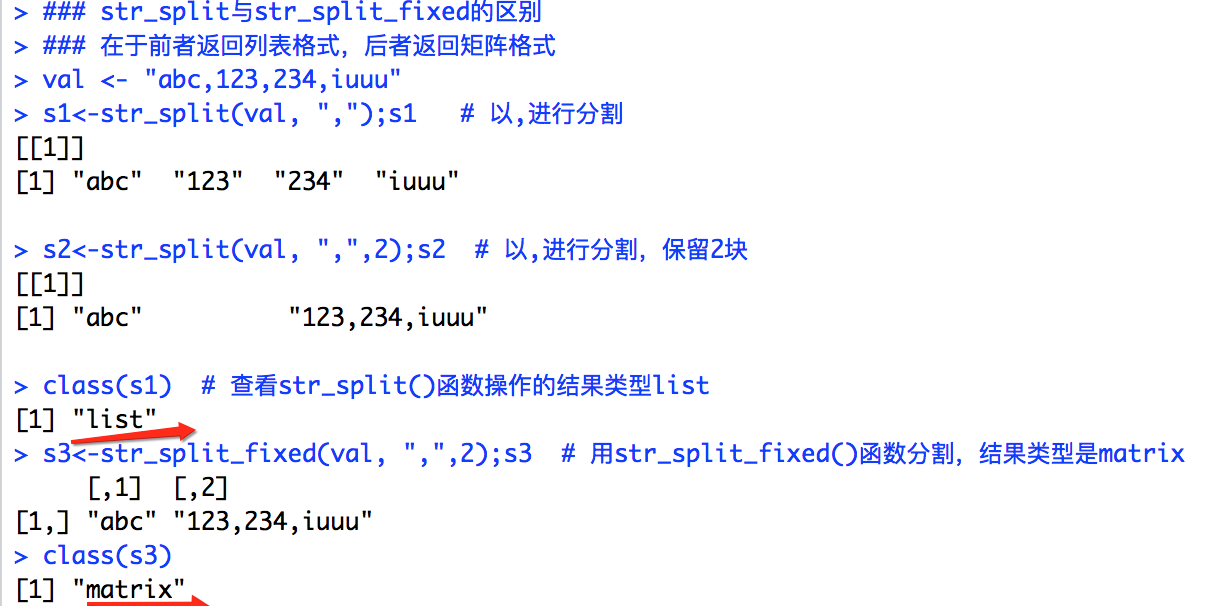
3.3.2 str_subset:返回的匹配字符串
函数定义:
str_subset(string, pattern)
参数列表:
string: 字符串,字符串向量。
pattern: 匹配的字符。
fruit <- c("apple", "banana", "pear", "pinapple")
str_subset(fruit, "a") ## 全文匹配
str_subset(fruit, "ap") ##返回含字符'ap'的单词
str_subset(fruit, "^a") ## 开头匹配
str_subset(fruit, "a$") ## 结尾匹配
str_subset(fruit, "b") ##返回含字符'b'的单词
str_subset(fruit, "[aeiou]") ##返回含'aeiou'任一个字符的单词
str_subset(c("a", NA, "b"), ".") #丢弃空值
#该函数与word()函数的区别在于前者提取字符串的子串,后者提取的是单词,而且str_sub也可以其替换的作用。
string <- 'My name is ABDATA, I’m 27.'
str_sub(string, -3,-2) <- 25; string
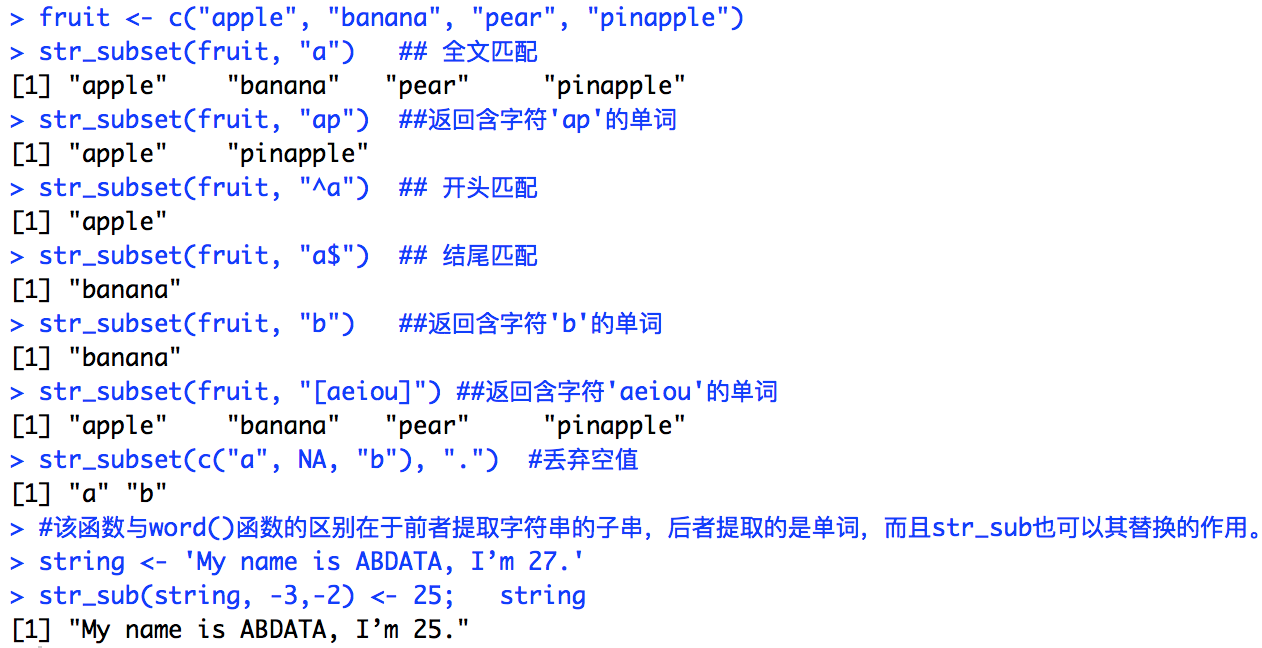
str_subset()函数与word()函数的区别在于前者提取字符串的子串,后者提取的是单词,而且str_sub也可以其替换的作用。
3.3.3 word, 从文本中提取单词(适用于英语环境下的使用)
函数定义:word(string, start = 1L, end = start, sep = fixed(" "))
参数列表:
- string: 字符串,字符串向量。
- start: 开始位置。
- end: 结束位置。
- sep: 匹配字符。
sentences <- c("nxl saw a cat", "nxl sat down")
word(sentences, 1) #提取第一个单词
word(sentences, 2) #提取第二个单词
word(sentences, -1) #提取句子的最后一个单词
word(sentences, 2, -1) #提取第二个单词到最后一个单词
word(sentences[1], 1:3, -1) #整个句子从第一个单词递减掉三个单词
word(sentences[1], 1:6, -1) #整个句子从第一个单词递减掉的单词
word(sentences[1], 1, 1:4) #从句子的第一个单词递增到第四个单词
str <- 'abc.def..123.4568.999'
word(str, 1, sep = fixed('..')) # 指定分隔符
word(str, 2, sep = fixed('..'))
word(str, 3, sep = fixed('..'))
val<-'111,222,333,444'
word(val, 1, sep = fixed(',')) # 以,分割,取第一个位置的字符串
word(val, 3, sep = fixed(','))

3.3.4 str_detect匹配字符串的字符-- 检测函数,用于检测字符串中是否存在某种匹配模式
函数定义:str_detect(string, pattern)
参数列表:
string: 字符串,字符串向量。
pattern: 匹配字符。
> val <- c("abca4", 123, "cba2")
# 检查字符串向量,是否包括a
> str_detect(val, "a")
# 检查字符串向量,是否以a为开头
> str_detect(val, "^a")
# 检查字符串向量,是否以a为结尾
> str_detect(val, "a$")
3.3.6 str_match,从字符串中提取匹配组
函数定义:
str_match(string, pattern)
str_match_all(string, pattern)
参数列表:
string: 字符串,字符串向量。
pattern: 匹配字符。
val <- c("abc", 123, "cba") # 从字符串中提取匹配组
str_match(val, "a") # 匹配字符a,并返回对应的字符
str_match(val, "[0-9]") # 匹配字符0-9,限1个,并返回对应的字符
str_match(val, "[0-9]*") # 匹配字符0-9,不限数量,并返回对应的字符
str_match_all(val, "a") #从字符串中提取匹配组,以字符串matrix格式返回
str_match_all(val, "[0-9]")
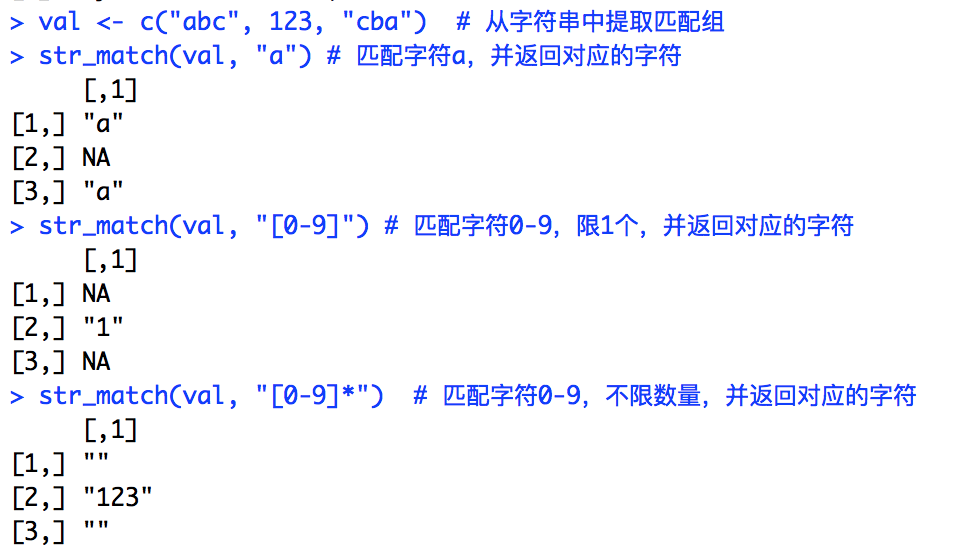

str_match()和str_match_all()区别在于前者只提取一次满足条件的匹配对象,而后者可以提取所有匹配对象
3.3.7 str_replace,字符串替换
函数定义:str_replace(string, pattern, replacement)
参数列表:
string: 字符串,字符串向量。
pattern: 匹配字符。
replacement: 用于替换的字符。
val <- c("abc", 123, "cba")
str_replace(val, "[ab]", "-") #替换第一个匹配的字符# 把目标字符串第一个出现的a或b,替换为-
str_replace_all(val, "[ab]", "-") #替换所有匹配的字符 # 把目标字符串所有出现的a或b,替换为-
str_replace_all(val, "[a]", "\1\1") # 把目标字符串所有出现的a,替换为被转义的字符
str_replace与str_replace_all的区别在于前者只替换一次匹配的对象,而后者可以替换所有匹配的对象

3.3.8 str_replace_na把NA替换为NA字符串
函数定义:str_replace_na(string, replacement = "NA")
参数列表:
- string: 字符串,字符串向量。
- replacement : 用于替换的字符。
把NA替换为字符串
> str_replace_na(c(NA,'NA',"abc"),'x')
[1] "x" "NA" "abc"
3.3.9 str_locate,找到的模式在字符串中的位置。
str_locate()和str_locate_all()的区别在于前者只匹配首次,而后者可以匹配所有可能的值
> str_locate(val, "a")
start end
[1,] 1 1
[2,] NA NA
[3,] 3 3
# 用向量匹配
> str_locate(val, c("a", 12, "b"))
start end
[1,] 1 1
[2,] 1 2
[3,] 2 2
# 以字符串matrix格式返回
> str_locate_all(val, "a")
[[1]]
start end
[1,] 1 1
[2,] 4 4
[[2]]
start end
[[3]]
start end
[1,] 3 3
# 匹配a或b字符,以字符串matrix格式返回
> str_locate_all(val, "[ab]")
[[1]]
start end
[1,] 1 1
[2,] 2 2
[3,] 4 4
[[2]]
start end
[[3]]
start end
[1,] 2 2
[2,] 3 3
string <- c('nxl123','zhazha234')
str_locate(string,'z')
str_locate(string,'n')
str_locate_all(string,'n')

3.3.10 str_extract从字符串中提取匹配模式
函数定义:
str_extract(string, pattern)
str_extract_all(string, pattern, simplify = FALSE)
参数列表:
string: 字符串,字符串向量。
pattern: 匹配字符。
simplify: 返回值,TRUE返回matrix,FALSE返回字符串向量
shopping_list <- c("apples 4x4", "bag of flour", "bag of sugar", "milk x2")
str_extract(shopping_list, "\\d") # 提取数字 #提取匹配模式的第一个字符串
str_extract(shopping_list, "[a-z]+") #提取字母
str_extract_all(shopping_list, "[a-z]+") # 提取所有匹配模式的字母,结果返回一个列表
str_extract_all(shopping_list, "\\d") # 提取所有匹配模式的数字
# 提取所有匹配模式的字符串,结果返回一个矩阵,通过simplify = TRUE设置
str_extract_all(shopping_list, "\\b[a-z]+\\b", simplify = TRUE)
str_extract_all(shopping_list, "\\d", simplify = TRUE)


str_extract(string, pattern) 提取匹配的第一个字符串
str_extract_all(string, pattern, simplify = FALSE) 提取匹配的所有字符串
功能与str_match(),str_match_all()函数类似
3.4 字符串变换函数
3.4.1 str_conv:字符编码转换
函数定义:str_conv(string, encoding)
参数列表:
- string: 字符串,字符串向量。
- encoding: 编码名。
对中文进行转码处理。
# 把中文字符字节化
> x <- charToRaw('你好');x
[1] c4 e3 ba c3
# 默认win系统字符集为GBK,GB2312为GBK字集,转码正常
> str_conv(x, "GBK")
[1] "你好"
> str_conv(x, "GB2312")
[1] "你好"
# 转UTF-8失败
> str_conv(x, "UTF-8")
[1] "���"
Warning messages:
1: In stri_conv(string, encoding, "UTF-8") :
input data \xffffffc4 in current source encoding could not be converted to Unicode
2: In stri_conv(string, encoding, "UTF-8") :
input data \xffffffe3\xffffffba in current source encoding could not be converted to Unicode
3: In stri_conv(string, encoding, "UTF-8") :
input data \xffffffc3 in current source encoding could not be converted to Unicode
把unicode转UTF-8
> x1 <- "\u5317\u4eac"
> str_conv(x1, "UTF-8")
[1] "北京"
3.4.2 str_to_upper,字符串大写转换。
函数定义:
str_to_upper(string, locale = "")
str_to_lower(string, locale = "")
str_to_title(string, locale = "")
参数列表:
- string: 字符串。
- locale:按哪种语言习惯排序
字符串大写转换:
> val <- "I am conan. Welcome to my blog! http://fens.me"
# 全大写
> str_to_upper(val)
[1] "I AM CONAN. WELCOME TO MY BLOG! HTTP://FENS.ME"
# 全小写
> str_to_lower(val)
[1] "i am conan. welcome to my blog! http://fens.me"
# 首字母大写
> str_to_title(val)
[1] "I Am Conan. Welcome To My Blog! Http://Fens.Me"
字符串在平常的数据处理中经常用过,需要对字符串进行分割、连接、转换等操作,本篇中通过介绍stringr,灵活的字符串处理库,可以有效地提高代码的编写效率。有了好的工具,在用R语言处理字符串就顺手了。
---------------------------------
常用功能:
# 合并字符串
fruit <- c("apple10", "banana"," ", "pe1ar", "pina22222pple","NA")
res <- str_c(1:4,fruit,sep=' ',collapse=' ')
str_c('I want to buy ',res,collapse=' ')
# 计算字符串长度
str_length(c("i", "like", "programming R", 123,res))
# 按位置取子字符串
str_sub(fruit, 1, 3)
# 子字符串重新赋值
capital <-toupper(str_sub(fruit,1,1))
str_sub(fruit, rep(1,4),rep(1,4)) <- capital
# 重复字符串
str_dup(fruit, c(1,2,3,4))
# 加空白
str_pad(fruit, 10, "both")
# 去除空白
str_trim(fruit)
# 根据正则表达式检验是否匹配
str_detect(fruit, "a$")
str_detect(fruit, "[aeiou]")
# 找出匹配的字符串位置(字符定位函数,返回匹配对象的首末位置)
str_locate(fruit, "a")
# 提取匹配的部分
str_extract(fruit, "[a-z]+")
str_match(fruit, "[a-z]+")
# 替换匹配的部分
str_replace(fruit, "[aeiou]", "-")
# 分割
str_split(res, " ")
str_extract(fruit, "\\d") # 提取数字
str_extract(fruit, "[a-z]+") #提取字母
注:R语言中正则表达式的不同之处是转义符号是“\\”,其他方面和通常的“正则表达式”是一样的
正则表达式定义
转义字符
\o NUL字符(\u0000)
\t 制表符(\0009)
\n 换行符(\000A)
\v 垂直制表符(\u000B)
\f 换页符(\000C)
\r 回车符(\000D)
\xnn 十六进制拉丁字符
\uxxxx十六进制unicode字符
\cX 控制字符
这些转义字符中比较常用的就是换行符了,其他记不住可以上网查。还有一些字符具有特殊含义,如果需要匹配这些字符的时候需要在前面加上反斜杠进行转义。
^ $ . * + ? = ! : | \ / ( ) [ ] { }
字符类
[...] 方括号内任意字符
[^...] 不在方括号内任意字符
. 除换行符和其他unicode行终止符之外的任意字符
\w 等价于[a-zA-Z0-9]
\W 等价于[^a-zA-Z0-9]
\s 任何unicode空白符
\S 任何非unicode空白符
\d 等价于[0-9]
\D 等价于[^0-9]
[\b] 退格
这个字符类很重要,需要记忆。
描述方式:重复
知识点
{n,m} 匹配前一项至少n次,不超过m次
{n,} 匹配前一项至少n次
{n} 匹配前一项n次
? 等价于{0,1}
+ 等价于{1,}
* 等价于{0,}
x? 描述符后跟随一个"?"表示非贪婪匹配:从字符串中第一个可能匹配的位置,尽量少的匹配。如“??”、“{1,5}?”等。
描述方式:选择、分组和引用
“|”与逻辑表达式中的或类似,前后两者任意一个匹配,很好理解。而圆括号用来分组和引用,功能就比较复杂了。
把单独的项组合成子表达式,以便重复、选择等操作。
完整的模式中定义子模式,从而在匹配成功后从目标串中抽出和圆括号中的子模式匹配的部分。
同一个正则表达式中后部引用前部的正则表达式,注意因为子表达式可以嵌套,所以它的位置是参与计数的左括号的位置。如果不创建带数字编码的引用,可以用"(?"和")"表示。
举个简单的例子,如果要匹配单引号或双引号中的字符,可能会写成下面这样:
/['"][^'"]*['"]/
但是如果我们是想成对的匹配'abc'而不是匹配'abc"的话需要这么改写:
/(['"])[^'"]*\1/
锚
指定匹配位置的元素称为锚。
^ 匹配字符串开头,多行匹配一行的开头
$ 匹配字符串结尾,多行匹配一行的结尾
\b 匹配一个单词的边界,位于\w和\W之间的位置
\B 匹配非单词边界
(?=p) 要求接下来的字符都与p匹配,但不能包括匹配p的那些字符
(?!p) 要求接下来的字符不与p匹配
修饰符
i。忽略大小写
m。多行匹配模式
g。全局匹配
字符串中的模式匹配
search
查找匹配的字符串,不支持全局匹配,返回第一个子串的起始位置。
"JavaScript".search(/script/i) //4
match
返回由匹配结果组成的数组,默认返回第一个匹配的字符串,如果全局匹配则返回所有匹配字符串。当使用括号分组的时候第一个元素为匹配的字符串,其后为圆括号中各个匹配的子字符串。
split
这是将字符串转化为数组的方法。一般用字符串做分隔符匹配,如果使用正则表达式,则在匹配字符串的前后方断开。同时注意以下几点:
匹配到开头内容,返回数组第一个元素为空字符串。
匹配到结尾内容,返回数组最后一个元素为空字符串。
未匹配,返回数组只包含未切分的字符串。
replace
$n 匹配第n个匹配正则表达式中的圆括号子表达式文本
$& 匹配正则表达式的子串
$` 匹配子串左边的文本
$' 匹配子串右边的文本
$$ 匹配美元符号
RegExp对象
属性
source 正则表达式文本
global 只读布尔值,是否有修饰符g
ignoreCase 只读布尔值,是否有修饰符i
multiline 只读布尔值,是否有修饰符m
lastIndex 下一次检索开始的位置,用于exec()和test()
方法
exec()
类似String.match,不过不能使用全局匹配。匹配同时修改lastIndex值为紧挨着匹配子串的字符位置,如果未匹配则为0。
test()
返回布尔值,可以修改lastIndex从指定位置开始匹配。
stringr包中的重要函数
| 函数 | 功能说明 | R Base中对应函数 |
|---|---|---|
| 使用正则表达式的函数 | ||
str_extract() |
提取首个匹配模式的字符 | regmatches() |
str_extract_all() |
提取所有匹配模式的字符 | regmatches() |
str_locate() |
返回首个匹配模式的字符的位置 | regexpr() |
str_locate_all() |
返回所有匹配模式的字符的位置 | gregexpr() |
str_replace() |
替换首个匹配模式 | sub() |
str_replace_all() |
替换所有匹配模式 | gsub() |
str_split() |
按照模式分割字符串 | strsplit() |
str_split_fixed() |
按照模式将字符串分割成指定个数 | - |
str_detect() |
检测字符是否存在某些指定模式 | grepl() |
str_count() |
返回指定模式出现的次数 | - |
| 其他重要函数 | ||
str_sub() |
提取指定位置的字符 | regmatches() |
str_dup() |
丢弃指定位置的字符 | - |
str_length() |
返回字符的长度 | nchar() |
str_pad() |
填补字符 | - |
str_trim() |
丢弃填充,如去掉字符前后的空格 | - |
str_c() |
连接字符 | paste(),paste0() |



 浙公网安备 33010602011771号
浙公网安备 33010602011771号